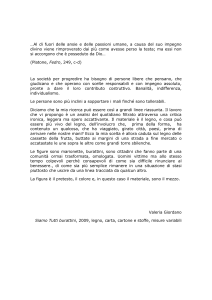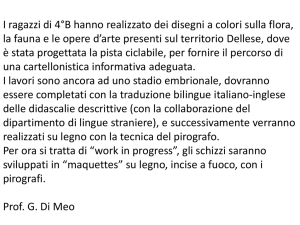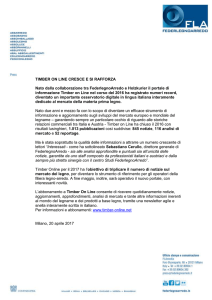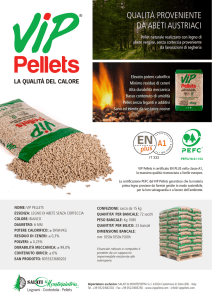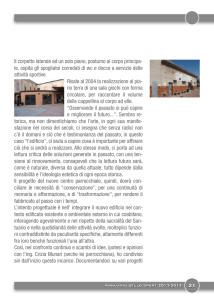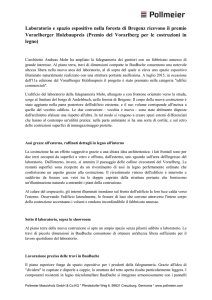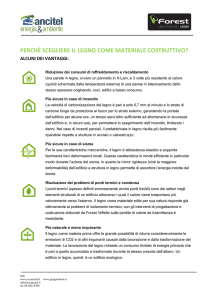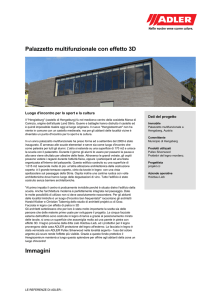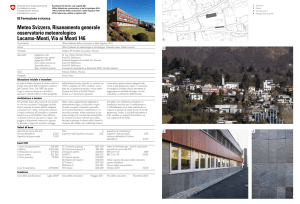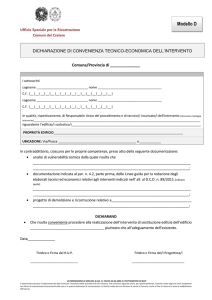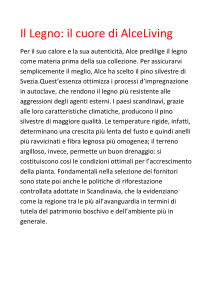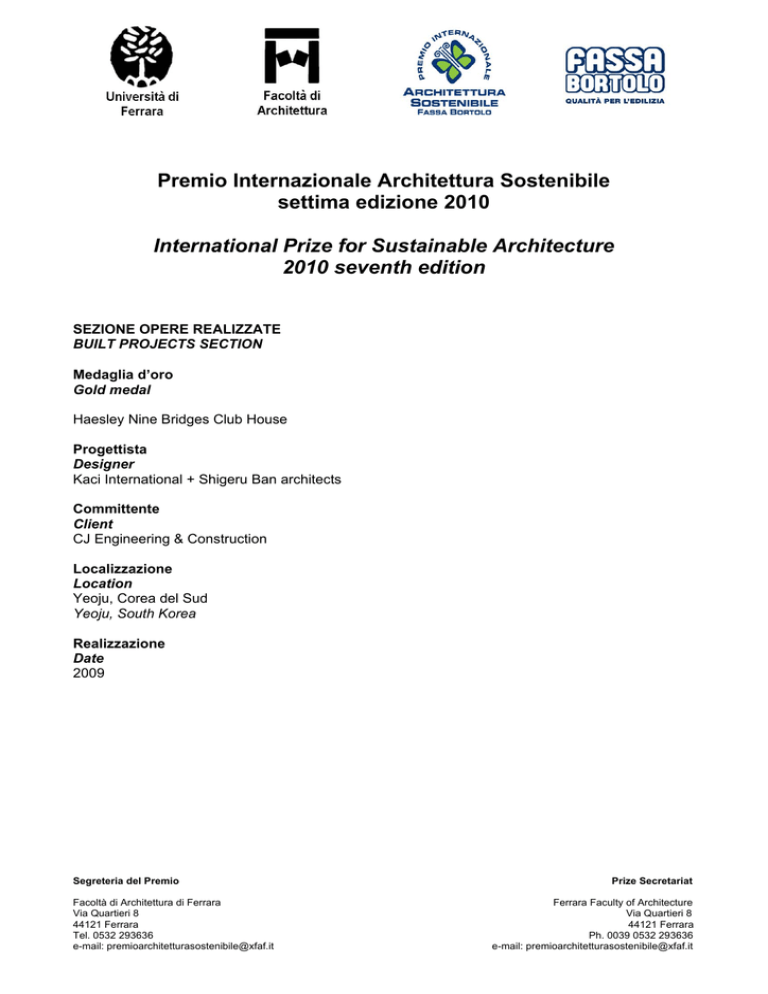
Premio Internazionale Architettura Sostenibile
settima edizione 2010
International Prize for Sustainable Architecture
2010 seventh edition
SEZIONE OPERE REALIZZATE
BUILT PROJECTS SECTION
Medaglia d’oro
Gold medal
Haesley Nine Bridges Club House
Progettista
Designer
Kaci International + Shigeru Ban architects
Committente
Client
CJ Engineering & Construction
Localizzazione
Location
Yeoju, Corea del Sud
Yeoju, South Korea
Realizzazione
Date
2009
Segreteria del Premio
Facoltà di Architettura di Ferrara
Via Quartieri 8
44121 Ferrara
Tel. 0532 293636
e-mail: [email protected]
Prize Secretariat
Ferrara Faculty of Architecture
Via Quartieri 8
44121 Ferrara
Ph. 0039 0532 293636
e-mail: [email protected]
IL PROGETTO
Nuovi metodi per massimizzare l’utilizzo di strutture di legno come
materiale più sostenibile
Questa clubhouse localizzata all’interno di un campo da golf, dista un’ora di auto
da Seoul. E’ composta da tre edifici diversi, uno per i membri regolari, un altro
per VIP members e l’ultimo per local VIP members.
Ogni singolo edificio é composto di tre sistemi diversi nella struttura.
La struttura dell’edificio dei membri regolari é composto da una conchiglia a
maglia esagonale di legno, una struttura ecologica e ventilata naturalmente che
segue il disegno dei tradizionali cuscini estivi coreani (chiamati “moglie del
Bamboo”).
L’edificio per i VIP locali ha invece una struttura di acciaio di piccolo passo quasi
a scala residenziale mentre l’edificio per i VIP members presenta una struttura di
cemento armato.
In ogni edificio si trova una riproposizione in chiave moderna delle tecniche
costruttive tradizionale della Corea del sud.
Innovazione e sostenibilità
La principale peculiarità della struttura della copertura dell’edificio principale è
che la maglia esagonale è interamente realizzata in legno.
Questa struttura di legno è resistente al fuoco e tetto e colonne si trovano a vista
nello spazio interno.
Nelle costruzioni contemporanee si trovani principalmente tre tipi di materiali:
acciaio, cemento e legno ma soltanto quest’ultimo è l’unico rinnovabile.
Il professore Klaus Richter dei Swiss Federal Labaratories ha fatto alcuni test sui
tre materiali diversi : acciao, cemento e legno dimostrando un risultato
interessante sul contenuto di CO2 per ogni materiale attraverso processo di
lenocinio per i materiali che compongono un edificio.
Qui sotto si può verificare i risultato di tali test.
Si vede chiaramente nel diagramma che il contenuto totale di CO2 che è creato
dal legno per la costruzione, è la metà di quello di una costruzione di cemento e
che è un terzo di quello delle costruzioni in acciaio.
Il nostro progetto utilizza una struttura in legno come come struttura principale in
un nuovo modo.
Grazie all’utilizzo di avanzate tecnologie e di precise macchine da taglio,
abbiamo potuto di trovare un’ottima forma per la struttura arrivando anche a
ridurre sprechi durante il processo di assemblaggio e la quantità di elgname
necessaria.
Questo nuovo sistema di struttura portante che abbiamo sviluppato è ora
utilizzato da molti architetti, ingegneri e clienti per le loro realizzazioni future di
edifici sostenibili.
THE PROJECT
New Way of maximizing Timber Structure as the most sustainable building
material
This clubhouse in the golf course located from Seoul to the south in the place of
one hour by the car. It is composed of three buildings of the clubhouses for
regular members and VIP members, and the accommodation for VIP members.
Each building is composed of three different structure systems. The regular
members' clubhouse building is composed of the wooden hexagon grid shell,
and this ecological and natural ventilated concept of Hexagon pattern occurred
from Korean traditional summertime pillow (called” bamboo wife”).
The VIP accommodation building is a small span of the steel structure in a
residential scale. The VIP members' clubhouse building is the reinforced
concrete structure. Each building has sublimed in the modern referring to
traditional construction of South Korea.
Innovation and Sustainability
The most innovative feature is the hexagon grid shell roof made of wood. This
wooden structure is fire-resistant and the roof and columns are exposed in the
interior spaces. In modern building technology even though there are mainly
three structural materials, Steel, Concrete and Wood but Wood is the only
renewable materials. The professor Klaus Richter of Swiss Federal Laboratories
for Materials Testing and Research has presented an interesting result from his
research comparing the total amount of CO2 created by three different materials,
Steel, Concrete and Wood through the process of procuring the materials to the
completion of the building. The results are shown in the diagram below.
As it is clear from the diagram, the total amount of CO2 created by Timer (Wood)
construction is half that of concrete construction and one-third of steel
construction. Additionally, wood has absorbed CO2 before they are cut down.
Our project utilized Timber Structure as the main structural material in a new way.
Using the most advanced technology of computers and cutting machines we
were able to find the most efficient structural form and minimized the assembling
process and quantity of timber. This development of the new timber structural
system will encourage architects, engineers and clients to utilize the sustainable
building ideas of for the future.

